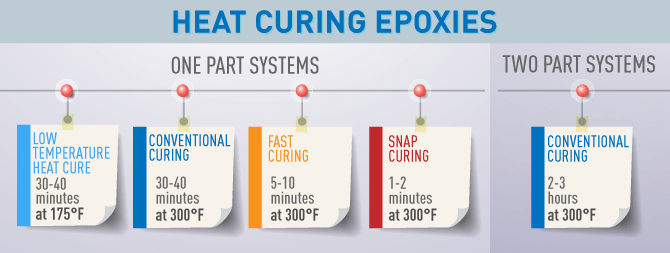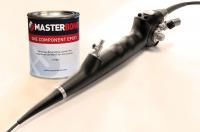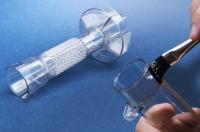One component heat curing epoxy systems can be divided into three categories based on time and temperature of curing: conventional, fast and snap curing systems. Select two part epoxies are engineered to cure only upon exposure to conventional heat.

For all epoxy systems thorough curing is necessary to achieve the highest cross linking density formation and thus the best performance properties. In general, longer cures deliver higher bond strength, chemical and temperature resistance. However, choosing the right adhesive system should be based on analyzing more criterias than just curing speed. Examples below demonstrate some performance properties of Master Bond epoxy systems.
Conventional curing one component epoxies
Typical cure schedules:
- 60-75 minutes to cure at 250°F (121°C)
- 30-40 minutes at 300°F (149°C)
Master Bond Supreme 10HT is a conventional cure system that is formulated to cure in 60-75 minutes at 250°F. It is serviceable from 4K to 400°F. This NASA low outgassing approved compound features superior shear and peel strength, withstands rigorous thermal cycling and has exceptional adhesion to similar and dissimilar substrates.
High compressive strength conventional curing EP13 exhibits temperature resistance up to +500°F and is readily machinable. It will cure at temperatures of 300-350°F for 60-90 minutes. For optimum properties, a post cure of 2 hours at 350-400°F is highly recommended.
Conventional curing two component epoxies
Typical cure schedules:
- 3-4 hours to cure at 250°F (121°C)
- 2-3 hours at 300°F (149°C)
Master Bond EP45HTAN is a thermally conductive, electrically insulative epoxy for bonding and sealing. This epoxy combines cryogenic temperature serviceability along with high temperature resistance up to 500°F. It features excellent strength retention at high temperatures.
Fast curing one component epoxies
Typical cure schedules:
- 20-30 minutes to cure at 250°F (121°C)
- 5-10 minutes at 300°F (121°C)
Fast curing Master Bond Supreme 3HTND-2DA is noted for its impressive dispensing profile (no tailing or bleed out) for die attach applications. This thermally conductive /electrically insulative adhesive has formidable die shear strength, low ionics and has successfully passed 85°C/85%RH.
Snap curing one component epoxies
Typical cure schedule:
- 1-2 minutes to cure at 300°F (121°C)
Moderate viscosity snap cure EP3SP5FL is a low shrinkage, reworkable epoxy engineered for high volume production usage. It provides potent physical strength and outstanding dielectric properties. Snap cure Master Bond EP17HT-3 can cure up to ¼ inch thick and is serviceable up to +400F.
Low temperature heat curing one component epoxies
Compounds can cure at temperatures 175 -210°F (80°- 100°C). Learn more about low temperature heat curing adhesives.
Curing equipment
Typically, convection ovens are the most widely used choice for curing epoxies. However, in special cases, equipments such as variable-frequency microwaves (VFM), induction ovens, or infrared ovens may also be applicable. Some of these novel techniques help speed up the curing process.
Some of Our Most Popular Heat Curing Systems
 |
EP126 Two part toughened epoxy system. Capable of continuous service at 500°F. 100% reactive. Unmatched durability. Outstanding chemical resistance. Robust physical strength profile. Dimensionally stable. Machineable. Withstands rigorous thermal cycling. Service operating temperature range from -80°F to +500°F. |
 |
EP110F8-5 High performance two component epoxy system for potting, sealing, encapsulating and casting. Moderate viscosity with good flow. Enhanced dimensional stability and superior thermal cycling resistance. Superb mechanical and electrical insulation properties. Serviceable from -100°F to +300°F. |
 |
EP3HTMed Rapid curing, one part epoxy. Meets USP Class VI biocompatibility standards. Thixotropic paste viscosity. High shear strength. Superb resistance to autoclaving, chemical sterilants, radition, EtO. Serviceable from -60°F to +400°F. |
 |
Supreme 3AOHT One component, fast heat curing system. Can withstand rigorous thermal cycling. Thermally conductive, electrically insulative. Paste viscosity. Serviceable up to 350°F. |
 |
EP17HT-LO One part, no mix epoxy meets NASA low outgassing specifications. Serviceable up to 600°F. Tg is 225°C. High shear, tensile and compressive strength properties. Cures in 90-120 minutes at 300F. Withstands 1000 hours 85°C/85% RH. |
 |
EP62-1 Cures rapidly at moderate elevated temperatures. Superior resistance to moisture. Two part epoxy has long pot life at ambient temperatures. High bond strength properties. Reliable electrical insulator. Serviceable from -60°F to +450°F. Withstands aggressive chemical exposure. Tg 160-165°C. Shore D hardnes >80. |
 |
EP132 Two part high temperature resistant epoxy system. Capable of service up to 550°F. 100% reactive. Unmatched durability. Outstanding electrical and physical strength properties. Service operating temperature range from -60°F to +550°F. |
